Physical Address
304 North Cardinal St.
Dorchester Center, MA 02124
Tumors of the endocrine pancreas are called pancreatic neuroendocrine neoplasms (PanNENs). PanNEN, like the neuroendocrine neoplasms (NENs) of the gastrointestinal tract, are stratified into two major groups ( Table 20.1 ), the well-differentiated NENs called pancreatic neuroendocrine tumors (PanNETs) and the poorly differentiated NENs called pancreatic neuroendocrine carcinomas (PanNECs). The PanNETs are further separated by their proliferative activity into either G1 NET (Ki67 index <3%, and mitotic rate <2 per 2 mm 2 ) ( Fig. 20.1A ), G2 NET (Ki67 index 3%–20%, or mitotic rate 2–20), and G3 NET (Ki67 index >20%, or mitotic rate >20). All PanNECs are high grade by definition (Ki67 index >20%) (see Fig. 20.1B ) and are subtyped into small cell and large cell neuroendocrine carcinomas (see Table 20.1 ). TNM (tumor, nodes, metastasis) staging of tumor extension leads to further stratification of PanNENs ( Table 20.2 ). The PanNENs that contain a significant adenocarcinoma component (exceeding at least 30% of all tumor cells) are distinguished from the pure NENs and called mixed neuroendocrine-nonneuroendocrine neoplasms (MiNEN) (see Table 20.1 ). This term replaces the term MANEC (mixed adenoneuroendocrine carcinoma) as not all nonneuroendocrine components are adenocarcinomas, and the neuroendocrine component rarely also can be well differentiated. Nonneuroendocrine carcinomas with a minority (<30%) of dispersed neuroendocrine cells (which are unlikely to influence their behavior) are called carcinomas with a neuroendocrine cell component. MiNEN is a conceptual category; the specific diagnostic terms applied to these neoplasms can reflect their respective cellular components, such as mixed ductal neuroendocrine carcinoma or mixed acinar neuroendocrine carcinoma.
| WHO 2000 | WHO 2010 | WHO 2017 |
|---|---|---|
| Well-differentiated endocrine tumor (WDET) | NET G1 | PanNET G1 |
| Well-differentiated endocrine carcinoma (WDEC) | NET G2 | PanNET G2 PanNET G3 |
| Poorly differentiated endocrine carcinoma–small cell carcinoma (PDEC) | NEC G3 | PanNEC |
| Small cell type | Small cell type | |
| Large cell type | Large cell type | |
| Mixed exocrine-endocrine carcinoma (MEEC) | MANEC | MiNEN |
| Tumorlike lesions | Hyperplastic and preneoplastic lesions |
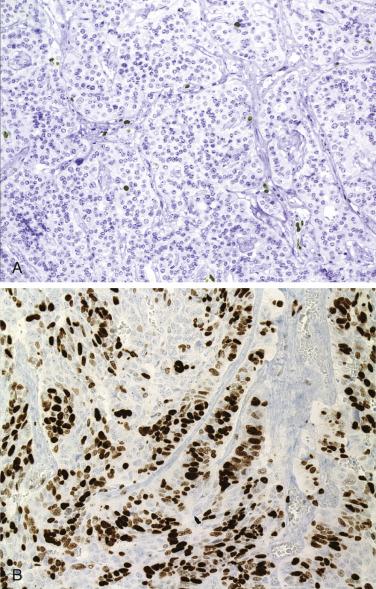
| T | Primary Tumor * |
|---|---|
| TX | Primary tumor cannot be assessed |
| T0 | No evidence of primary tumor |
| T1 | Tumor limited to pancreas ** , <2 cm in greatest dimension |
| T2 | Tumor limited to pancreas ** 2 cm but <4 cm in greatest dimension |
| T3 | Tumor limited to pancreas ** , >4 cm in greatest dimension or tumor invading duodenum or bile duct |
| T4 | Tumor perforates visceral peritoneum (serosa) or other organs or adjacent structures |
| N | Regional Lymph Nodes |
| NX | Regional lymph nodes cannot be assessed |
| N0 | No regional lymph node metastasis |
| N1 | Regional lymph node metastasis |
| M | Distant Metastasis |
| M0 | No distant metastasis |
| M1 | Distant metastasis |
| M1a | Hepatic metastasis only |
| M1b | Extrahepatic metastasis only |
| M1c | Hepatic and extrahepatic metastases |
| Stage | |
| Stage I | T1, N0, M0 |
| Stage II | T2, T3, N0, M0 |
| Stage III | T4, N0, M0 |
| Any | T, N1, M0 |
| Stage IV | Any T, Any N, Any M |
* The TNM classification of PanNECs follows the criteria for classifying ductal adenocarcinomas.
** This includes invasion of the peripancreatic adipose tissue.
PanNETs and PanNECs are two distinct tumor groups: PanNETs may be clinically functioning or nonfunctioning, express hormones, and arise in patients with endocrine neoplasia syndromes, such as multiple endocrine neoplasia type 1 (MEN-1) and von Hippel–Lindau syndrome (VHL), whereas PanNECs and MiNENs are usually nonfunctioning neoplasms, do not express hormones, are not associated with endocrine neoplasia syndromes, and are highly aggressive.
Functioning (syndromic) PanNETs are associated with a hormonal syndrome and classified according to the hormone causing the syndrome, for example, insulinoma, glucagonoma, gastrinoma, vipoma, adrenocorticotropinoma (or adrenocorticotropic hormone [ACTH] tumor), serotoninoma (PanNET with carcinoid syndrome), and growth hormone–releasing factor (GRF) tumor (GRFoma). These terms also apply to functioning neoplasms, even if they turn out, on immunohistochemistry, to be multihormonal. Nonfunctioning PanNETs comprise all neoplasms not associated with a distinct hormonal syndrome, even if the majority of the cells express and commonly also secrete hormones, such as glucagon, pancreatic polypeptide, somatostatin, or calcitonin. Nonfunctioning PanNETs account for more than 60% of all PanNETs.
PanNETs with a diameter of less than 0.5 cm, the minimum size required for reliable gross detection, are considered microadenomas. Such tumors, which are always nonfunctioning, may be difficult to distinguish from large islets (300 µm). Immunohistochemically, however, they can be discriminated from the latter by their monohormonal or randomly multihormonal composition. Microadenomatosis is a term signifying the occurrence of multiple microadenomas in the pancreas, as may be seen in MEN-1, VHL, or glucagon cell hyperplasia and neoplasia (GCHN; see “ Diseases Associated With Multiple PanNETs ”).
PanNETs can occur anywhere in the pancreas. Most of them are solitary and well-demarcated tumors (even if they show invasion into surrounding tissues) and have a firm or rarely soft consistency ( Fig. 20.2 ). The cut surface is solid whitish-yellow to pinkish-brown or, less frequently, dark red or cystic. Cystic lesions appear to be most common in the pancreatic tail. The size typically ranges between 1 and 5 cm, although larger cases can occur. Surgically removed insulinomas are generally smaller (<2 cm) than other functioning and nonfunctioning neoplasms, suggesting that glucagonomas, vipomas, and other hormonally active tumors require a relatively large volume to produce clinical symptoms. The size of the neoplasm is not related to the severity of the hormonally induced symptoms. In cases in which more than one tumor is detected, inherited endocrine neoplasia syndromes should be suspected. PanNETs that are either large or located next to the main pancreatic duct may cause upstream duct dilatation and obstructive chronic pancreatitis, sometimes simulating an intraductal papillary mucinous neoplasm radiographically.
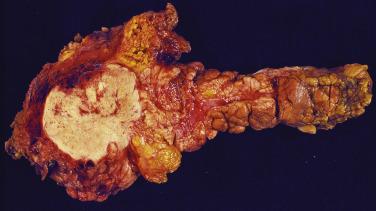
PanNETs are usually composed of relatively uniform cuboidal cells with finely granular eosinophilic cytoplasm and centrally located round to oval nuclei that often display a distinct nucleolus. Occasionally single cells with large pleomorphic nuclei are found. Mitoses are usually infrequent, less than 20 per 10 high-power fields (hpf). In rare cases the tumors consist of pleomorphic cells, clear cells, vacuolated lipid-rich cells, oncocytic cells or contain cells with black pigment, periodic acid–Schiff–positive globules, or rhabdoid inclusions. The growth patterns that may be observed include either a trabecular ( Fig. 20.3 ), gyriform, pseudoglandular ( Fig. 20.4 ), true glandular, solid medullary, or paraganglioma-like arrangement of the tumor cells ( Fig. 20.5 ). Not infrequently, more than one pattern may occur within the same neoplasm. Trabecular or glandular tumors show polarized nuclei, whereas tumors with solid growth patterns do not. The amount of vascular stroma and stromal hyalinosis is variable and can be very prominent ( Fig. 20.6 ). The hyaline stroma may show small foci of calcification, and psammoma bodies may also be found. At the tumor margin, nonneoplastic elements such as islets and ducts can be found entrapped in the tumor.
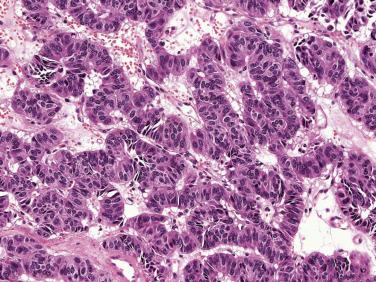
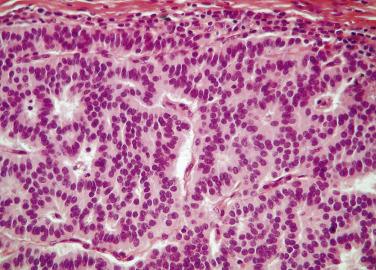
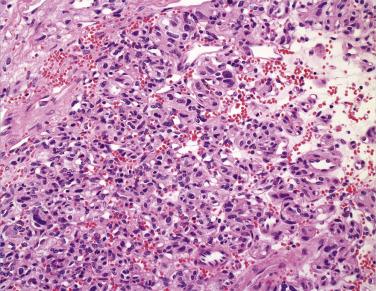
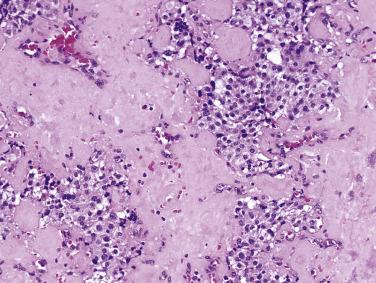
A small subset of well-differentiated PanNETs will show an increased proliferation rate (Ki-67 >20%), and these tumors are diagnosed as PanNET G3. Generally the mitotic rate remains less than 20 per 10 hpf, however. Morphologic criteria of well-differentiated PanNETs include organoid/nesting/trabecular/gyriform growth patterns, as opposed to large expanding infiltrative sheets of poorly differentiated PanNECs (WHO, 2017). However, morphology alone is not always sufficient to separate well-differentiated NETs from poorly differentiated NECs. A combination of morphology with genetic markers (DAXX/ATRX loss in PanNETs, RB loss, or P53 overexpression/loss in PanNECs) and clinical history (a high-grade neoplasm with evidence of progression from a PanNET that remains well differentiated) seems to be helpful.
From the histologic appearances of a tumor, no conclusions can be drawn as to its functional state or the type of hormone produced. Three exceptions exist however: (1) Glandular structures containing psammoma bodies (as may be seen in ampullary NETs) or paraganglioma-like structures (see Fig. 20.5 ) with pleomorphic cells are commonly observed in somatostatin-positive PanNETs ; (2) amyloid deposits ( Fig. 20.7 ) are indicative of insulinomas (see later section on insulinomas ); and (3) tumors with clear cell features are sometimes indicative of the VHL syndrome.
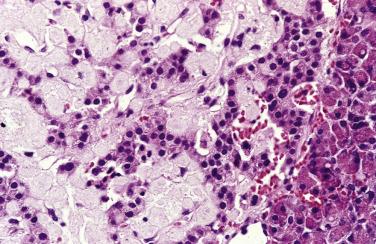
Fine-needle aspiration may be useful in establishing a preoperative diagnosis. Aspirates from PanNETs are often cellular, showing clusters of loosely cohesive cells. The cells are uniform and relatively small and have small round nuclei, which are somewhat eccentric, producing a plasmacytoid appearance ( Fig. 20.8 ). Their cytoplasm is often scanty and grayish-pink or granular and varies from clear to dense.
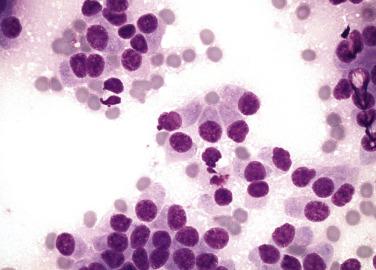
The general neuroendocrine markers, synaptophysin and chromogranin A, reveal the neuroendocrine nature of the tumors. The staining intensity of synaptophysin ( Fig. 20.9 ) is independent of the number of secretory granules in the cells or the type of hormone produced, whereas the staining intensity of chromogranin A, which is stored in secretory granules, depends on the number of the latter in the cells and the type of hormone produced ( Fig. 20.10 ). Other markers that also recognize the neuroendocrine phenotype are chromogranins B and C, HISL-19, neuron-specific enolase (NSE), and the proprotein convertases PC2 and PC3. The neural cell adhesion molecule NCAM/CD56 is also positive in many PanNETs, but none of the markers other than chromogranin A and synaptophysin are considered sufficiently specific or sensitive to be diagnostically useful. In addition to neuroendocrine markers, PanNETs may stain for progesterone receptors; CD99; cytokeratins 8, 18, and 19 (but rarely for cytokeratin 7); and occasionally for CA19-9. Trypsin or chymotrypsin may be positive in single widely scattered cells; labeling of more than 30% indicates a diagnosis of mixed acinar neuroendocrine carcinoma, which should be considered when limited staining for chromogranin or synaptophysin is detected.
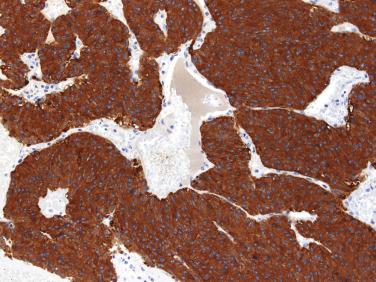
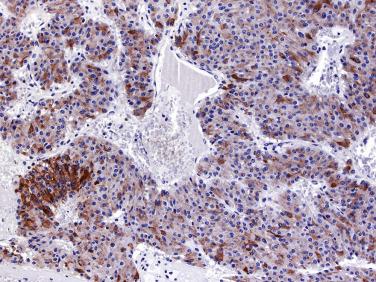
Hormone (cell type)–specific markers are helpful in detecting the hormone causing the symptoms in the majority of functioning tumors at the light and electron microscopic levels. However, neither the staining intensity nor the number of stained cells correlates with the severity of hormonally induced symptoms. In general, the distribution of immunostained cells is uneven, and metastases may produce hormones not found in the primary tumor. Because of inappropriate and rapid or constitutive hormone secretion, individual hormone-producing pancreatic tumors may be immunohistochemically negative for the respective peptide, though in situ hybridization for localization of the related messenger RNA yields positive results. If stained with a battery of antisera against various hormones, many tumors turn out to be multihormonal.
Isl-1, a lineage marker for pancreatic endocrine cells, is almost exclusively expressed in well-differentiated NETs of the pancreas and duodenum and can indicate pancreatic or duodenal origin for well-differentiated neuroendocrine tumor metastases of unknown primary. PAX-6, PAX-8, and PDX-1 expression can also be seen but are not as specific for pancreatic origin. CDX-2 expression is rarely found in PanNETs (those expressing serotonin) and is frequently positive in ileal and appendiceal NETs.
The specific ultrastructural feature of PanNET cells is the membrane-bound electron-dense secretory granule. The number, size, and shape of these granules depend on the type and the differentiation of the tumor cells. In some well-differentiated tumors, secretory granule morphology may be indicative of the hormone stored, and it may thus be possible to identify the cell type(s).
Pancreatic NECs are white-gray masses with ill-defined borders, often showing areas of necrosis and hemorrhage. They have an average diameter of approximately 4 cm ( Fig. 20.11 ).
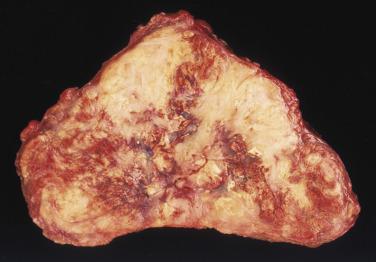
PanNECs show a variable histologic pattern, consisting either of tightly packed cell nests; diffuse, irregular sheets of cells; or solid structures with some palisading of the peripheral cells. Necrosis is frequent and often geographic or comedo-like, and mitoses are abundant, generally more than 20 per 10 hpf and sometimes more than 50 per 10 hpf. PanNECs are subdivided into small cell or large cell NECs, depending not only on the size of the neoplastic cells but also on the presence and prominence of nucleoli. In NECs of small cell type, which may resemble small cell carcinoma of the lung, the chromatin-dense nuclei have absent or inconspicuous nucleoli, whereas NECs of large cell type have distinct nucleoli and less dense chromatin ( Fig. 20.12 ). Large cell PanNECs are more common than small cell PanNECs.
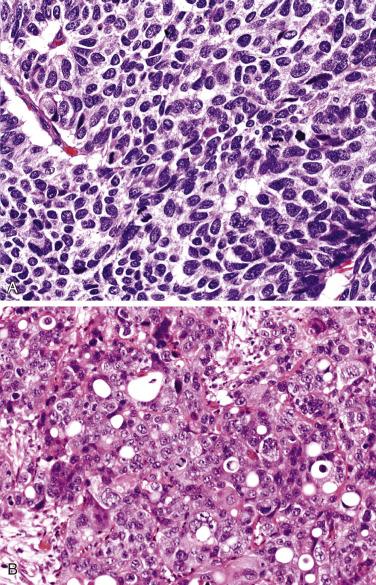
The poorly differentiated PanNENs are barely recognizable as neuroendocrine neoplasms histologically and therefore require the immunohistochemical demonstration of synaptophysin and chromogranin A for a reliable diagnosis, though small cell NECs are occasionally chromogranin A negative. PanNECs commonly show membranous CD56 and aberrant (loss or overexpression of) p53 immunoreactivity or loss of retinoblastoma protein. Ki67 is expressed in over 20% of the tumor cells. Although the labeling index of some PanNECs (small cell carcinoma in particular) may exceed 50%, occasionally large cell NECs have a Ki67 index between 20% and 50%, overlapping with the range of PanNETs G3. Isl-1 is not helpful in identifying or excluding the pancreatic origin of these tumors. Ultrastructurally the secretory granules of PanNECs are not diagnostic and may be very sparse.
Become a Clinical Tree membership for Full access and enjoy Unlimited articles
If you are a member. Log in here